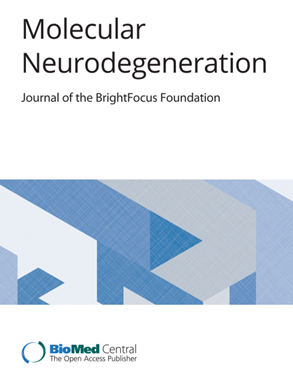A versatile mouse model to advance human microglia transplantation research in neurodegenerative diseases
IF 17.5
1区 医学
Q1 NEUROSCIENCES
引用次数: 0
Abstract
Recent studies highlight the critical role of microglia in neurodegenerative disorders, and emphasize the need for humanized models to accurately study microglial responses. Human-mouse microglia xenotransplantation models are a valuable platform for functional studies and for testing therapeutic approaches, yet currently those models are only available for academic research. This hampers their implementation for the development and testing of medication that targets human microglia. We developed the hCSF1Bdes mouse line, which is suitable as a new transplantation model and available to be crossed to any disease model of interest. The hCSF1Bdes model created by CRISPR gene editing is RAG2 deficient and expresses human CSF1. Additionally, we crossed this model with two humanized App KI mice, the AppHu and the AppSAA. Flow cytometry, immunohistochemistry and bulk sequencing was used to study the response of microglia in the context of Alzheimer’s disease. Our results demonstrate the successful transplantation of iPSC-derived human microglia into the brains of hCSF1Bdes mice without triggering a NK-driven immune response. Furthermore, we confirmed the multipronged response of microglia in the context of Alzheimer’s disease. The hCSF1Bdes and the crosses with the Alzheimer’s disease knock-in model AppSAA and the humanized App knock-in control mice, AppHu are deposited with EMMA and fully accessible to the research community. The hCSF1Bdes mouse is available for both non-profit and for-profit organisations, facilitating the use of the xenotransplantation paradigm for human microglia to study complex human disease.一种多功能小鼠模型推进神经退行性疾病的人小胶质细胞移植研究
最近的研究强调了小胶质细胞在神经退行性疾病中的关键作用,并强调需要人源化模型来准确研究小胶质细胞的反应。人类小鼠小胶质细胞异种移植模型是功能研究和测试治疗方法的一个有价值的平台,但目前这些模型仅用于学术研究。这阻碍了他们开发和测试针对人类小胶质细胞的药物。我们开发了hCSF1Bdes小鼠系,它适合作为一种新的移植模型,并且可以与任何感兴趣的疾病模型杂交。CRISPR基因编辑构建的hCSF1Bdes模型RAG2缺失,表达人CSF1。此外,我们将该模型与两种人源化App KI小鼠AppHu和AppSAA杂交。采用流式细胞术、免疫组织化学和批量测序技术研究了小胶质细胞在阿尔茨海默病中的反应。我们的研究结果表明,ipsc衍生的人小胶质细胞成功移植到hCSF1Bdes小鼠的大脑中,而没有引发nk驱动的免疫反应。此外,我们证实了小胶质细胞在阿尔茨海默病中的多管齐下的反应。hCSF1Bdes及其与阿尔茨海默病敲入模型AppSAA和人源化App敲入对照小鼠AppHu的杂交与EMMA一起沉积,完全可向研究界开放。hCSF1Bdes小鼠可用于非营利和营利性组织,促进了人类小胶质细胞异种移植范式的使用,以研究复杂的人类疾病。
本文章由计算机程序翻译,如有差异,请以英文原文为准。
求助全文
约1分钟内获得全文
求助全文
来源期刊

Molecular Neurodegeneration
医学-神经科学
CiteScore
23.00
自引率
4.60%
发文量
78
审稿时长
6-12 weeks
期刊介绍:
Molecular Neurodegeneration, an open-access, peer-reviewed journal, comprehensively covers neurodegeneration research at the molecular and cellular levels.
Neurodegenerative diseases, such as Alzheimer's, Parkinson's, Huntington's, and prion diseases, fall under its purview. These disorders, often linked to advanced aging and characterized by varying degrees of dementia, pose a significant public health concern with the growing aging population. Recent strides in understanding the molecular and cellular mechanisms of these neurodegenerative disorders offer valuable insights into their pathogenesis.
 求助内容:
求助内容: 应助结果提醒方式:
应助结果提醒方式:


